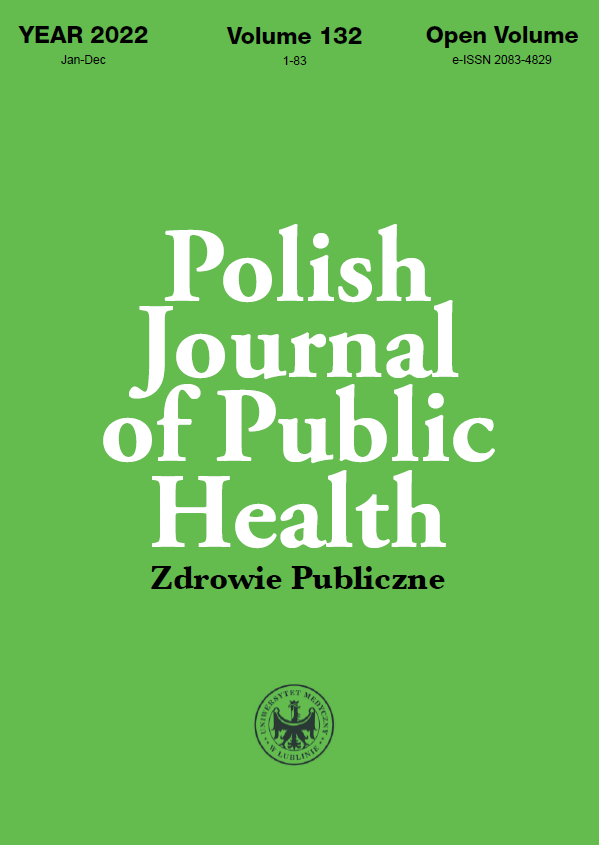Sex differences in masticatory muscle activity in healthy young adults
DOI:
https://doi.org/10.2478/pjph-2022-0008Keywords:
SEMG, masticatory muscles, sex, young adultsAbstract
Introduction. Several studies analyzed the gender differences in masticatory muscle activity. Previous scientific reports indicate the predominance of the masseter muscle activity in male subjects and the predominance of the temporalis anterior in women. However, there is a lack of studies analyzing the differences in the activity of the mandibular abduction muscles between men and women.
Aim. The presented study evaluated the sex differences in activity within temporalis anterior, masseter, and digastric muscle
in healthy young adults.
Material and methods. Thirty-six healthy young adults aged 20 to 29 years (mean 22±2.6 years) were qualified for the presented study. The subjects were divided into two equal groups (n=18) in terms of gender. The masticatory muscle activity was recorded within the temporalis anterior (TA), the superficial masseter muscle (MM), and the anterior bellies of the digastric muscle (DA). Electromyographic activity was recorded in three conditions: at rest, during maximum voluntary clenching at the intercuspal position, and during maximum voluntary clenching with cotton rolls between teeth.
Results. Significant differences in electromyographic activity between the male and female group were observed within resting activity for the TA-R (Women: 1.98 µV vs. Men: 1.26 µV; p=0.000), TA-L (Women: 2.13 µV vs. Men: 1.33 µV; p=0.000), DA-R (Women: 2.17 µV vs. Men: 1.29 µV; p=0.001), DA-L (Women: 2.13 µV vs. Men: 1.37 µV; p=0.005). Moreover, significant difference in resting activity index was observed within left side (Women: -9.89 % vs. Men: 10.39%; p=0.037), and within right side during clenching with cotton rolls between teeth (Women: 9.83% vs. Men: 25.59%; p=0.016).
Conclusions. Women represent higher resting sEMG activity within the temporalis anterior and digastric muscles than men. Electromyographic patterns may be influenced by gender at rest and during clenching tasks.
References
1. Ingerslev CH, Solow B. Sex differences in craniofacial morphology. Acta Odontol Scand. 1975;33(2):85-94.
2. Avci S, Ergun T, Aydin E, Kansu L. Sex differences in adult craniofacial parameters. Surg Radiol Anat. 2015;37(9):1069-78.
3. McNamara JA, Ellis E. Cephalometric analysis of untreated adults with ideal facial and occlusal relationships. Int J Adult Orthodon Orthognath Surg. 1988;3(4):221-31.
4. Shinogaya T, Bakke M, Thomsen CE, et al Effects of ethnicity, gender and age on clenching force and load distribution. Clin Oral Investig. 2001;5(1):63-8.
5. Julien KC, Buschang PH, Throckmorton GS, Dechow PC. Normal masticatory performance in young adults and children. Arch Oral Biol. 1996;41(1):69-75.
6. Ferrario VF, Sforza C, Miani A, et al. Electromyographic activity of human masticatory muscles in normal young people. Statistical evaluation of reference values for clinical applications. J Oral Rehabil. 1993;20(3):27180.
7. Wieczorek A, Loster JE. Activity of the masticatory muscles and occlusal contacts in young adults with and without orthodontic treatment. BMC Oral Health. 2015;15(1):116.
8. Naeije M, McCarroll RS, Weijs WA. Electromyographic activity of the human masticatory muscles during submaximal clenching in the inter-cuspal position. J Oral Rehabil. 1989;16(1):63-70.
9. Ginszt M, Zieliński G, Byś A, Gawda P, Majcher P. Masticatory muscles activity in sport climbers. Int J Environ Res Public Health. 2020;17(4):1378.
10. Proffit WR, Fields HW, Nixon WL. Occlusal forces in normal- and long-face adults. J Dent Res. 1983;62(5):566-70.
11. Pietropaoli D, Ortu E, Giannoni M, et al. Alterations in surface electromyography are associated with subjective masticatory muscle pain. Pain Res Manag. 2019;2019:6256179.
12. Nalamliang N, Sumonsiri P, Thongudomporn U. Are occlusal contact area asymmetry and masticatory muscle activity asymmetry related in adults with normal dentition? CRANIO. 2020;0(0):1-9.
13. Hatef B, Talebian S, Hashemirad F, Ghaffarpour M. Effect of pain on the timing pattern of masseter muscle activity during the open-close-clench cycle in the migraine without aura and tension type headaches. Iran J Neurol. 2012;11(4):146-50.
14. Wieselmann-Penkner K, Janda M, Lorenzoni M, Polansky R. A comparison of the muscular relaxation effect of TENS and EMG-biofeedback in patients with bruxism. J Oral Rehabil. 2001;28(9):849-53.
15. Rodrigues-Bigaton D, Berni KCS, Almeida AFN, Silva MT. Activity and asymmetry index of masticatory muscles in women with and without dysfunction temporomandibular. Electromyogr Clin Neurophysiol. 2010;50(7-8):333-8.
Downloads
Published
Issue
Section
License
Copyright (c) 2022 Authors

This work is licensed under a Creative Commons Attribution-NonCommercial-NoDerivatives 3.0 Unported License.


